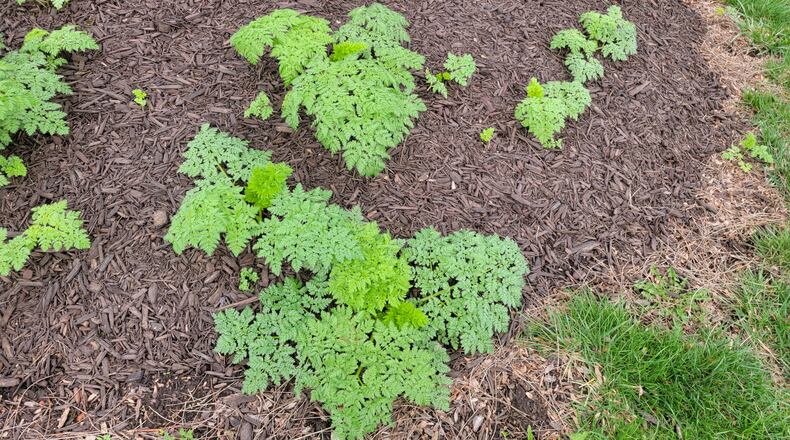Over the last several years I have watched this plant slowly make its way through the Miami Valley. What was once a weed alongside corn fields and ditches is now showing up in landscapes and gardens.
Poison hemlock and wild parsnip are biennial weeds; the first year is just vegetative growth and is in the form of a rosette. A rosette is where the leaves are circular or whorled around the base of the plant or stem and in flowering plants, they usually sit low to the ground.
The second year of growth of a biennial is when the plants send up flower blooms and goes to seed, ensuring the survival of the plant through the next generation.
Poison hemlock is commonly and improperly identified as Queen Anne’s lace. They are in the same family but are entirely different plants. In addition, Queen Anne’s lace blooms later in the summer season while poison hemlock.
The flowers appear in early June, are flat-topped, and look like dainty white umbrellas (called umbels). The seeds are prolific and can germinate in the fall or may stay in the ground for four to six years. After bloom, the plant dies, but don’t worry, the seeds carry on.
One of the best distinguishing characteristics to use in identifying poison hemlock is the purple blotches on the stems. Queen Anne’s lace and wild parsnip do not have these purple blotches.
All parts of the poison hemlock plant are poisonous if ingested. The sap can also enter the skin through the eyes, nose, and cuts in the skin. Keep in mind that this is the plant that was used to kill Socrates!
Wild parsnip is also a problem in the landscape with its yellow umbrella-like flowers. The sap is known to cause phytophotodermatitis, meaning if the sap is on the skin and in the sun, blisters will develop on the area of skin.
These blisters resemble burns and can be quite painful. It may cause darkened spots on the skin for a period.
As I said above, now, in the early growth, rosette stage, is the best time to control with herbicides. It’s much easier to kill the rosettes than it is the blooming plant.
If you are eradicating the plant by hand, or with a mower or weed eater, wear personal protective equipment and avoid inhalation of the plant sap on poison hemlock. Wear long sleeves when cutting wild parsnip.
There is one more problematic plant in this group, giant hogweed; fortunately, I haven’t seen it in our area. It is in northeast Ohio and grows six feet tall. It is also poisonous.
Look all of these plants up and know how to identify them in case you spot them in your landscape.
Pamela Corle-Bennett is the state master gardener volunteer coordinator and horticulture educator for Ohio State University Extension. Contact her by email at bennett.27@osu.edu.
